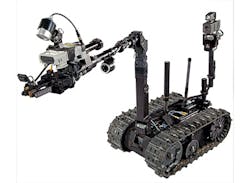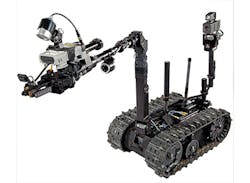Navy orders unmanned ground vehicle
INDIAN HEAD, Md. - U.S. Navy bomb disposal experts are beefing-up their inventory of unmanned ground vehicle (UGV) robots that are designed to detect, pinpoint, and neutralize improvised explosive devices (IEDs) and other roadside bomb threats.
Officials of the Naval Surface Warfare Center Indian Head Explosive Ordnance Disposal Technology Division in Indian Head, Md., has announced a $10.2 million order to QinetiQ North America in Waltham, Mass., for continued production of the MK2 Man Transportable Robotic System (MTRS).
The MK2 MTRS from QinetiQ is one of several MTRS designs that provides stand-off capability to detect, identify, and dispose of IEDs and related hazards using an unmanned ground vehicle equipped with special IED-disposal payloads.
The MTRS provides the ability to locate, identify, and clear land mines, unexploded ordnance, and IEDs in the path of maneuvering Army or Joint forces.
The QinetiQ version of the MTRS is based on the company's TALON tracked unmanned ground vehicle. These lightweight vehicles are designed for IED and explosive ordnance disposal, reconnaissance, communications, countering chemical, biological, radiological, nuclear, and explosive (CBRNE) threats, security, heavy lift, defense, and rescue missions.
Talons can move as fast as six miles per hour, are transportable by one person, work in bad weather and rugged terrain, and have high payload capacity and payload-to-weight ratios. The TALON V provides 16 I/O ports including Interoperability Profile (IOP) A and B connectors; has JAUS AS4-compliant software; supports plug and play discovery of IOP devices; offers a variety of high-definition and standard-definition camera options in addition to an optional, dual-purpose thermal/daytime zoom camera; has a heavy-lift multiple-degree-of-freedom arm manipulator; and supports a variety of third-party and legacy TALON manipulators.
This order to QinetiQ is to exercise option two of MK2 MTRS production, as well as for depot-level repair parts, spare kits, approved accessories, consumable parts, reconditioning, conversions, engineering enhancements, and configuration management in support of the Joint Service Explosive Ordnance Division program.
QinetiQ won the company's original $9.4 million MTRS contract in September 2014. The company won a separate $9.9 million MTRS order in September 2015.
QinetiQ will do the work in Waltham, Mass., and should be finished by September 2016.
FOR MORE INFORMATION visit QinetiQ North America online at www.qinetiq-na.com, and the Naval Surface Warfare Center Indian Head Explosive Ordnance Disposal Technology Division at www.navsea.navy.mil/Home/Warfare-Centers/NSWC-Indian-Head-EOD-Technology.

